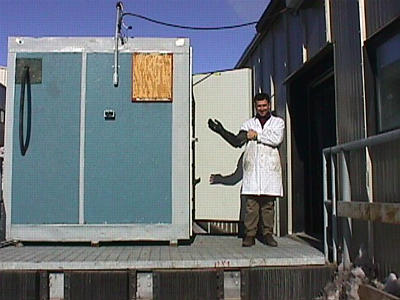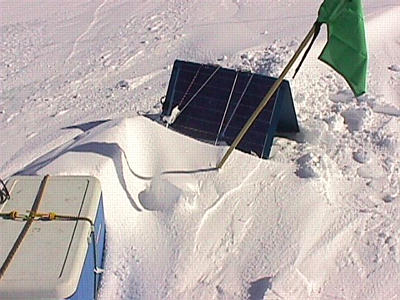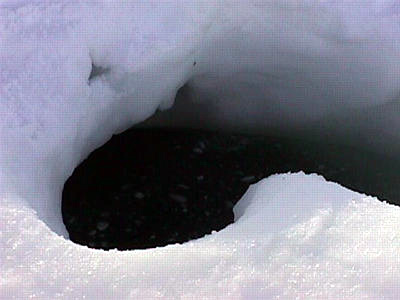25 November, 1998
Wednesday, November 25th, 1998
Hello everyone! Today was a key day for the Cape Roberts Project. At 3:00 PM
they stopped drilling out at Cape Roberts. As of this morning the drill hole
was down to 612 meters, and by the time they stopped this afternoon, it was
around 625 meters. There were several hours set aside this afternoon for hole
conditioning, and this evening the downhole loggers were making their
measurements.
Meanwhile, back in Crary Lab, we have about 4-5 more days of core processing
and sampling to do. After that we have MANY measurements to make and samples
to pack up. It will be a busy few weeks until we leave Antarctica! There was
20 new meters of core to look at today…481 through 507.88. I also spent time
labeling yesterday's samples and measuring susceptibility. That seems to be
my routine.
A break in the action came today when I called Husmann Elementary School (my
school) for the first time. I needed to talk with a few people there to make
arrangements for a phone conference and CU-SeeMe conference we're trying to
set up. It was good to hear the voices of a few friends back home. It won't
be long before I'm back in Crystal Lake.
Fabio and I did our usual…drilling…from 4:00 until about 5:00 PM today. I
have included a photo of the little freezer building that we use. Again, the
drilling went faster today because Sonia helped us out. I was back in the lab
until 6:00 PM again…labeling, measuring and doing some demag samples. The
final member of our team arrived late this afternoon…Andy Roberts…from
England. He came down on today's Herc flight from New Zealand. Since we're
going to be busy, it's good to have another paleomag person in the lab!
After dinner I went straight to the computer lab where I worked on answering
e-mails and starting a journal entry. I had lots of mail again, and that took
the majority of my time. I met with my roommate, Andrea Donnellan, and we
left the lab around 9:30 to go to the Coffee House so that I could interview
her. She has a neat role to play in Antarctic research.
Andrea works at the Jet Propulsion Lab in Pasadena, California. She gave me a
couple of web sites that you might want to check out. I also have another one
listed that I forgot to tell you about yesterday….it's from the seal
researchers. Here goes:
http://geodynamics.jpl.nasa.gov/antarctica
http://scign.jpl.nasa.gov/learn
http://siniff3.ecology.umn.edu
Hope you can check those out and learn something new from each site. Let me
know what you find out.
Andrea is a geophysicist, and studies earthquakes in southern California. She
also works with technology and plans projects that include technology. She
travels quite often and has worked on projects in Mongolia, Bolivia (at 14,000
feet above sea level), Antarctica (five times), and southern California. She
has also attended meetings and looked at faults in Chile and Japan. She
really moves around.
Andrea's project here in Antarctica is in Marie Byrd Land…and Andrea will be
traveling to this remote area to set up a GPS device. GPS stands for Global
Positioning System. They will be using this device to measure plate tectonics
and continental drift. Marie Byrd Land is moving away from Cape Royds and
McMurdo. They can measure how fast it is moving by using this machine for a
period of several years. Their device will use solar and wind power to charge
a battery that runs the equipment. They will put out a tower (windmill), dome
(antenna), and a piece of equipment like a spike that stays very level. The
equipment will measure latitude, longitude, and height, and how that changes
over time.
When their remote field camp is established, they will travel by Twin Otter
(small plane), Skidoos, and possibly skis (towing sleds with equipment on
them). They have 1,000 pounds of equipment to get out to the remote site.
600 pounds will stay there. The rest is supplies they will need to set the
device up…generator to run a jackhammer, drill, and other tools. Once the
site is set up, it will be checked each year and information that is logged
for that year will be collected. What an interesting project. I am
constantly amazed at the interesting people I meet here and the fascinating
projects they are involved with.
That's it for today. Talk to you tomorrow!
Betty :)

This is where I spend several hours each day, drilling small samples from the core that arrrives in Crary Lab.

I thought I would share some additional photos from yesterday's trip to visit with the scientists studying seals at Big Razorback. This is the radio transmitter t hat is attached to some of the male seals.

The Coleman cooler protects the battery and computer component used with the radio transmitter. The solar panels (to the right) recharge the battery.

We were lucky enough to see LOTS of seals popping their heads up out of the water in ice holes such as this one. Sometimes we even saw a mom and pup. We saw seals slipping into ice holes to get back into the water, and seals trying to get out of ice holes. Neat stuff!

In this photo, Mike works on tagging the seal, while Dan holds the bag over the seal's head. It takes a lot of team work to make this process successful!

Just some of the food that is available to the members of the Big Razorback field camp. They had some good stuff. Thanks for the Chips Ahoy cookies!
Contact the TEA in the field at
.
If you cannot connect through your browser, copy the
TEA's e-mail address in the "To:" line of
your favorite e-mail package.
|
